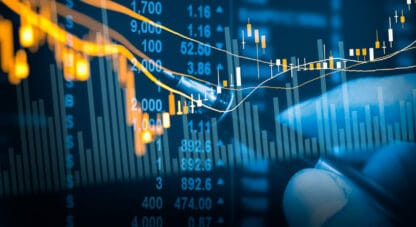The McAlvany Weekly Commentary
with David McAlvany and Kevin Orrick
“Risk is coming out of the market. Private equity companies have dumped up to 73 billion dollars in companies that they have owned through the first six months of the year. What is the battle cry, if you will, amongst private equity firms and stock investors who are beginning to second guess the direction of the market? Liquidity, liquidity, liquidity – if you don’t have enough of it, you are going to want it.”
– David McAlvany
Kevin: Of course, Dave, this week we are going to talk about interest rates. We have to. We have been getting the question so often asked, “Is the Federal Reserve finally going to raise interest rates, or at least say that they are going to raise interest rates?” But before we get to that, we ought to look at what this week’s schedule looks like as far as other things in the financial markets because there have been people who have named dates this fall, and they have said, “Cataclysm is going to occur on this date, or cataclysm is going to occur on that date.” I think your dad found, and you have found through the years, that people who name dates are almost always humbled, aren’t they?
David: Crystal ball clarity simply just doesn’t exist. But this is a very packed week and you look at where Monday started with the Bank of Japan monetary policy meeting and of course early in the week, Rosh Hashanah, so you had, frankly, a slower start to the week on Wall Street. Wednesday and Thursday of this week we have the Fed meeting. And there is always lots of activity before a Fed meeting, front-running, if you will.
Kevin: This one in particular, don’t you think?
David: Oh, absolutely, because this one is considered to be a game changer, and I think that leaves many traders and investors sort of off balance. “What can we expect, because this may be a directional shift?” What do I mean by that? Well, interest rates have been set at zero for seven years now, from 2008 to the present, and so this would be a pretty considerable shift off of what has become the normal and expected context.
Now, as we get to Friday, there is another issue and this is sort of fourth on the list of what makes this week particularly interesting and perhaps volatile. You have options and futures expiration on Friday, what they call triple-witching, where you have index futures, you have index options, and stock options all expiring on the same week. And so that usually invites added volatility in the stock market, as moneyed interests seek to push prices in or out of the money, and that is talking about options, specifically. But you generally see these vested interests, people who have made considerable bets – they want to see their bets pay off, and they are willing to spend a little money to push the market, nudge the market – “noodge” the market – a little bit, if you will, in the direction that they need it to go.
Kevin: So how much volatility do you think that might bring this week?
David: Well, more volatility than usual when you couple that with the Fed announcement to raise or not to raise – that is the question. We could see a 1,000-point swing in either direction. You could see the Dow up 1,000, you could see the Dow down 1,000, as we head toward the end of the week, because again, triple-witching with the options and futures and stocks – this is a reality, it is always more volatile.
But on top of that, the Fed pronouncement of a 25-basis point, 50-basis point, 75-basis point move in interest rates, or nothing. And what is critical, when you look at things from a technical standpoint is, the U.S. markets, thinking of both the Dow and the S&P, when you are looking at a chart you have something of a wedge formation forming. For the S&P, if you break out to the upside on the wedge formation that is forming there in the charts, you could go to 2045 pretty quickly. And that move, alternatively, if it breaks down, we revisit the 1867 level, the most recent lows, and you have to pray that that number holds or it is going considerably lower. We could be talking about a complete market collapse.
Kevin: Dave, you don’t often get into chart technical analysis on this program. It is too hard to visualize. But what you are talking about, a wedge looks like a pennant, like a football pennant for people who are fans, a little flag. And as a market’s volatility comes down to the point of that flag, it is going to make a decision up or down. But the chart analysts, whether it is a self-fulfilling prophecy or not, the analysts are watching for what direction it is going to go, and then they break hard that direction right afterwards.
David: Yes, it breaks hard one direction or the other. So in that context, you have September to October, which is always a vulnerable timeframe for the markets, and this year even more so with events in China, deterioration in the emerging markets, the Fed posturing on changing tack, and a variety of other unknowns that have the market sort of resting in uncertainty.
Kevin: Dave, the polls right now are showing that consumers are nervous. This spring we brought out a problem because everyone was just asleep – like they were in a hypnosis state. That doesn’t seem to be the case right now.
David: Growing concern, University of Michigan consumer sentiment numbers were surprisingly weak last week, and I think, again, this is where understanding where the Fed is – this is very critical. We have created a tremendous amount of liquidity – the Fed has.
Kevin: Trillions.
David: And the question is now, how do they reduce the risk of inflation picking up at an undesirable pace, while at the same time tightening monetary policy? So you have the trillions of dollars which they have created, those trillions have been put into the banking system, those trillions have been re-deposited with the Fed and are represented as excess reserves of depository institutions on the Fed balance sheet.
Kevin: But they are sitting behind a dam. They haven’t really seeped into the economy. Remember our interview with Charles Goodhart.
David: Right. I don’t know if that was six months ago, or 12 months ago, his sort of offhand comment when I raised this issue of there being excess liquidity and it being sort of a potential inflation charge, he said, “No, they’ll just sterilize it. They’ll sterilize liquidity.”
Kevin: Yes, we looked at each other like, “What does that mean – sterilize?”
David: Yes, well, it is somehow taking away its potency. And there is, I think, one way that they can certainly approach it, if that can be done, and that is by maintaining or increasing the interest paid on excess reserves.
Kevin: Right.
David: So you have these banks which have been given free money. They took the free money and instead of loaning it into the marketplace, re-deposited it with the Fed and they are collecting interest on it.
Kevin: Isn’t it strange, Dave, that Congress passed, right before the financial crisis in 2008, the law that allowed the Federal Reserve to do that, to pay interest on excess reserves?
David: That’s right, because prior to 2008 that was not the case. They have been collecting interest on excess reserves, and it is interesting because that number has grown from 10 billion to now 2.6 trillion dollars. Again, I say that the interest paid may be sort of a carrot version of the incentivization instead of a stick. “We’ll just pay you tens of billions in interest to not loan out the money we gave you in the first place.” Which is kind of twisted when you think about it because the original intent was to create liquidity in order to create economic activity, and now it hasn’t done that, and they are afraid that if that liquidity, in fact, gets into the system at an unmeasured pace, an uncontrolled pace, it could create the unfavorable conditions of higher than expected inflation.
Kevin: And it is bad enough that it is U.S. banks that we are talking about, paying billions of dollars to keep them from loaning money out, but didn’t some of this money go to foreign banks, as well?
David: Well, not just some. You are talking about, of the 2.6 trillion that is sitting there, over a trillion in excess reserves held at the Fed is from domestic branches of foreign banks. So these are foreign banks that are going to collect up to tens of billions of interest from the Fed, again, on payment of these excess reserves. So the financial subsidy – as you say, it is not merely of your Wells Fargos, your Bank of Americas, and the likes of J.P. Morgan, but it goes well beyond our borders.
And we can ask if that is the proper use of funds. The more critical thing as far as the Fed is concerned – is this politically palatable? And that is important because at this point anything they do to raise the ire of Congress increases the likelihood of an audit. And this has been sort of a populist idea, that we should audit the Fed, for a long period of time.
Kevin: Bullard came out and actually told Congress a couple of weeks ago, “Hey, look, this is what we are considering. Do you guys have any problems with this?”
David: “If you’re uncomfortable with this, speak now or forever hold your peace.”
Kevin: Exactly.
David: They didn’t get much response back to them, so for anyone interested in exploring this issue, I would encourage you to look at the New York Times article dated September 13th titled, “The Fed’s Policy Mechanics Re-Tool for a Rise in Interest Rates.” It outlines many of the things that we are talking about here and how the Fed will pay banks tens of billions of dollars not to use the trillions it paid them previously – kind of an interesting twist.
Kevin: Dave, you had mentioned earlier that we were at zero interest rates – ZIRP. But actually, if you factor in the real interest rate, aren’t we negative?
David: Well, sure. If you are factoring in the quasi rate of inflation, the official CPI, you are looking at negative 1.5%. The Fed Funds Rate is a negative 1.5% rate, which is unbelievably accommodative. And so I think it is very critical for perspective because whatever the Fed does, if it is nothing, we remain at negative 1.5%, which is really juicing the system at an extraordinary level.
Kevin: So even if they raise it a quarter of a point…
David: Now, you’re negative 125 basis points, 1.25%. It’s still incredibly accommodative. Quite frankly, to get on the other side of things and have a restrictive monetary policy, you have to have a positive rate by 1-2%. Again, let’s go back to the Taylor Rule, which would be, basically, that your rate needs to be commensurate with the rate of inflation. We are negative that by 150 basis points to 200 basis points. You see what I am saying?
Kevin: Well, even John Taylor, when we interviewed him, knew that interest rates had to go up much more dramatically than they are talking about to even come close to what you are talking about.
David: Yes, so I would just say this. We are talking about an extraordinarily accommodative situation, even with a rise in the base rate of 25 basis points, and it does not represent tightening. I’ll put it in this kind of language – it’s less loose monetary policy. It is still very loose, it is 25 basis points, 50 basis points, and as we mentioned maybe two months ago – the classic three steps and then a stumble, that is really what the stock market needs to be concerned with. You could see stock market volatility right here and right now, but the bigger stock market volatility comes when you get to a second or third rise in interest rates, where your signal to the market is, the trend has officially changed.
It is not just a one-off event, it is not just that we promised we would do something so we are following through, but when people begin to see a directional shift, and see that the long-term trend is for tightening monetary policy, again, confirmed by a second, a third, a fourth interest rate increase, then you have to start recalibrating, and then you begin to see a re-appraisal of all the values assessed to stocks, bonds, real estate, etc. Anything that is interest rate sensitive gets re-appraised and re-priced, as and when you see that directional shift.
Kevin: And it is still with the assumption that the Federal Reserve is in control, even if they do raise it one, two, three, or four times. Interest rates have a way of taking over. You talked last week about the bond vigilantes. There is a point where interest rates have a life of their own. It is a little bit like what we are seeing, Dave, in the foreign currencies right now. These countries thought they had control of their currencies – they have been collapsing. I am not talking just the BRIC countries, I’m talking everyone.
David: That’s right. Most of your losses have been in the emerging markets to date. You can argue that that is where the best value lies, but it is also where the greatest risks lie, as well. Goldman-Sachs popularized the “next eleven” which was sort of an add-on to their original acronym, BRIC. You probably recall, BRIC stands for Brazil, Russia, India and China. And those were countries that did very well during a certain period of time, particularly as they related to trade with China.
And as China was increasing its footprint financially, lo and behold Brazil, Russia, and a variety of other emerging markets tagged along for a growth trend. And so we have the “next eleven” which are now the next eleven in freefall – the Philippines, Bangladesh, there is a whole host of them that, on the basis of demographics could be growing, but on the basis of capital flows are actually in freefall.
This is a critical point. When capital beings to flow, or reverse from its inflow, and you see an outflow of capital, these are very small markets and they are impacted dramatically. We are talking about currencies, we are talking about bond markets, we are talking about equity markets – all tend to crater and get crushed at the same time.
Kevin: And the “B” in BRIC, Brazil, has now been moved to junk status. And so, we are talking junk bond status, which means probably they’re not going to pay their debt.
David: To some degree, I think there is reason to be concerned. Brazil was moved to junk status by S&P and that will be followed on by Moody’s and Fitch at some point. And at present the country is headed for its longest recession since the 1930s. Bloomberg reports that this is, basically, as bad as you have seen it in multiple generations. The implications are significant here in the United States for bond funds and emerging market fund managers. You have institutions, as well, such as pensions and insurance companies, which face either an end to future investment in Brazil, at a bare minimum, or an actual divestment now as a possibility, given that there are certain credit quality parameters that managers have to stay within.
So as bad as it has been in the entire Brazilian economy, the Brazilian financial sector, I think, is going to come under even more pressure. They have significant amounts of dollar-based borrowings, and those loans have been through a variety of international banks. When I look at this from a historical perspective, it is the same mistake that is made over and over and over again, where international banks will loan to places around the world where they can achieve a higher rate of interest. And they did that. They did it in U.S. dollar terms so that they weren’t taking currency risk on the loans, but the Brazilian financial sector, on the other hand, did take the currency risk.
Kevin: And then the dollar went up, and the real went down.
David: That’s the currency risk that I’m speaking of. So, your Brazilian financials earn revenues in reals, they pay dollar debt in dollars, ergo, a massive real devaluation creates a burden for that dollar-based debt. It is on the increase, which raises a very interesting point. You have Jim Grant who has vocalized significant concern with emerging markets, hither and yon, all over the world, who have borrowed in dollars. Emerging market debt, in local currency terms, has already suffered greatly. In other words, as long as that emerging market debt is priced in reals, or rand, or whatever the currency may be, you have seen the value of that debt go down tremendously.
Kevin: Let’s just say that you bought your house, Dave, and you had a similar type of arrangement, and your mortgage all of a sudden went up from whatever you were paying, let’s say 3-4%, to 10%, 15%, 20%, because of a currency devaluation. Let’s say that you had taken on a currency risk, as well. That’s unpayable. If you were paying 30% interest right now on your mortgage, you would walk away from that mortgage.
David: And then there were a number of Eastern European countries, including Hungary, that a number of years ago – we highlighted this – were taking advantage of low rates in the Swiss market. And so, cross-border lending increased and Swiss banks were willing to loan on Eastern European mortgages, and as those Eastern European countries saw their currencies devalued vis-à-vis the Swiss franc, that low interest loan became a high burden because you had to make up the difference in terms of the currency exchange rate.
Kevin: Then Hungary just basically said, “We’re not going to pay it unless you let us pay it in our currency.”
David: That’s right. So, you actually had a governmental intervention to save the bacon of the average voter in Hungary. But let’s go back to this issue in Brazil, and in the emerging markets in general, because as long as the debt is in local currency terms you have already seen a major haircut on those debts. Interestingly, very interestingly, the same kind of debt, if it is priced in U.S. dollars – and they have issued a tremendous amount of that – its price has barely budged.
This is the important point I would like to highlight. Brazil puts in the spotlight the issue that there is a currency play on international debt. But that is only one component in the valuation of that debt. And if you have been subject to risk in reals you have taken it on the chin. There are other risks in play which have not been acknowledged at this point. Credit risk is another, and I think it has been largely ignored. You have the international bond investor who is assuming that if the international bond is priced in dollars then it is a safe bet.
So they have avoided the currency mismatch catastrophe, I grant you that. But what if Russia hits a wall fiscally and has to default? What if Brazil fiscally hits a wall and has to default? What about other emerging market countries where, on a fiscal basis, they simply can’t make payments. Now all of a sudden, that credit risk comes to the fore, and I think this is one of the reasons why Brazil is in the limelight, for me. It underscores this issue. Brazilian dollar-based debt has not been punished. Russian dollar-based debt has not been punished.
Kevin: In other words, the markets are not adjusting for the correct risk at this point.
David: That’s right.
Kevin: The price has not been discounted.
David: And yet, as of last week, as the S&P moves into junk status, now people have to scratch their heads and say, “Oops, we thought it was just a currency thing that we were trying to avoid. Credit – we had never assumed that the government was going to be downgraded.”
Kevin: So the Efficient Market Hypothesis, which everyone learned from the 1970s on, is just a bunch of bunk, because the Efficient Market Hypothesis basically says that all information is priced correctly into the market all the time.
David: And this is our longstanding criticism of the Efficient Market Hypothesis. One risk is acknowledged, that of currency depreciation. Other risks are ignored, and are not priced in. The conclusion is, there is another significant lag down in the emerging markets, in the bond markets, and it is a credit quality re-appraisal, and I think that clock is ticking.
Kevin: Well, if you can’t pay a bond in a certain amount of time, I guess what you could do is just extend it almost indefinitely. Remember those bonds that we talked about that weren’t 30-year bonds, 50-year bonds, 80-year bonds – these were 100-year bonds. I guess you could probably go with a bond that has no maturity, just call it an infinite bond.
David: And there are those. They are called perpetuals. This is not one of them, though. Petrobras – as we talked about half a year ago, whenever these were issued, 100-year bonds issued by Petrobras, which is the state-owned oil company in Brazil. Remember, institutions gobbled these up because in a zero interest rate environment you know what they were saying to themselves.
Kevin: “Let’s get 5%.”
David: “Where else can you get better than 5%? We can get 5% with these bonds.”
Kevin: Isn’t that what it’s called – the magic 5%? That’s what everyone looks for.
David: And sometimes going after the magic 5% requires that you check your brain at the door. That is the case here, where again, we talked about currency risk, we talked about credit risk. Now you have that third category in the bond world – duration risk. You have 100 years – in that timeframe things can go either very right or very wrong, for Brazil, and for Petrobras.
Now, look back at another Latin American country. In the last 100 years what has happened, either right or wrong, in Argentina? You begin to look at the accumulation of mistakes made, fiscally and monetarily, and if you were betting on a state-owned company, in the last 100 years in Argentina we wouldn’t be talking about taking a 15% of 20% loss, which you have already seen with these Petrobras bonds. It is traded as low as 69 cents on the dollar, slightly recovered from there. But we’re talking about zero return of your capital – zero return of your capital – if you are talking about a country like Argentina. I don’t know how you bet on Petrobras or Brazil on a 100-year basis.
Kevin: Let’s look at someone else in the BRICs then. We started with the “B”, let’s go on to the “C.” China has been devaluing their currency. What was it? Three times they devalued their currency. A past guest of ours, Barry Eichengreen, really feels that that is foolhardy. It doesn’t really lend itself to a worldwide perception of stability.
David: This is a nuanced position because he believes that the RMB, the renminbi, should be, and will be, a part of the international monetary architecture. He sees that, he believes it, he promotes it.
Kevin: Even if not this year, maybe next year, or the year after that.
David: Right. And he sees that as not something that will destabilize the world or the world’s financial markets, but is “fair.” Maybe that’s not his word but he certainly sees it as inevitable and to everyone’s advantage. I disagree with that. You can listen to our commentary, our interview with him, but this is what he says about the devaluation in China recently. Quite honestly, Kevin, this complements where we concluded a few weeks ago, which is to say, you can do 2% here, but ultimately, it is only going to matter if you have done 10%, or 20%, or 30%. There has to be more of a devaluation for it to matter. And he says if they’re doing this piecemeal, they’re making a mistake. He says, “They may have just violated the first rule of devaluation – don’t cut off the cat’s tail in slices.”
Kevin: Just do it.
David: Yes. And he goes on to downplay the Special Drawing Rights, the SDR inclusion, as what he calls a vanity project.” The real significant progress, he believes, in internationalizing the RMB, is going to come from further development of the Chinese capital markets. Quite frankly I don’t know how that happens in this context – it seems like a devolution, not an evolution, positively, at this moment in time, but also, beginning to bring in private and official foreign investors into the RMB. And he has been pushing this for five to seven years.
Kevin: Well, and Dave, we have to look at Eichengreen’s viewpoint. He really wants to see the dollar lose its reserve currency status. He says it is inevitable, and he has diminished its importance through the years as he has written about it and taught at Berkeley about it.
David: Yes, I think to capture his perspective on that you would want to read his book, Exorbitant Privilege. It is an argument where he basically says, “We need to see the dollar minimized as the world reserve currency, and other currencies simultaneously elevated.” If you don’t have time to read the book, you can comb through our archives and we have that interview with him where we talk about the plusses and minuses of that approach. I still conclude that the benefits conferred having world reserve currency status outweigh any drawbacks. And quite frankly, that it is in our best interest to maintain reserve currency leadership. That may be less advantageous to the rest of the world, but it does still remain advantageous to the United States, and quite frankly, as I live here in the United States it is difficult for me to not appreciate the benefits conferred [laughs].
Kevin: Well, we have all enjoyed the benefits conferred. But sticking to the Chinese, if what he is saying is true, that more strength in the capital markets needs to be seen, we are actually seeing capital outflows. We are seeing massive outflows of money right now from China. These guys are taking their money and running.
David: It is a multi-year trend with over a trillion dollars exiting China last year and comparable numbers in motion this year, according to Treasury studies. And so, the Chinese are suggesting that there is going to be greater exchange rate flexibility and an opening up of the capital markets, and maybe they are taking the long-term view to that. Over the next six years, or ten years, I think that can certainly happen, but over the next six months, where in this environment one has to recall, again, how debilitating hot money exiting a market can be – speculative foreign direct investment that all of a sudden leaves a country. That is a key ingredient in any international financial crisis. And I think if they do liberalize their exchange rate flexibility and capital control rules, you would see this flood of money become something that absolutely craters China’s potential.
Kevin: You used the words: flood of money. What makes this particular crisis, let’s say, in the BRICS and in the emerging markets, maybe different – let’s go ahead and take the other side of the equation. These guys have a lot of surplus reserves in liquidity that they didn’t have the last time we had a crisis in Asia.
David: I think that is the way the bullish contingent would argue in the marketplace, and they are rightly acknowledging a very significant difference between now and the last time we saw either the Asian markets or the Latin American markets collapse. The trade surpluses of the last 10-15 years have armed many of these countries with large international reserves. That basically gives them the resources, the ammo, so to say, to defend their currencies from catastrophic declines, which would be triggered by capital flight or hot money flowing out of the country.
And the counterpoint, I think, is best illustrated by Russia. It is a country which, as we speak, is chewing through its reserves in a failed attempt to stabilize the ruble, and it reminds us that the question of how much is necessary, how much is enough, is determined by two things – the lengthiness of the crisis period, and its intensity.
Kevin: In other words, how much ammunition do you bring to the firefight?
David: Yes, exactly. If you ask a soldier how much ammunition you need, doesn’t it depend on those two things? How long is the engagement, and how intense is the battle? Emerging markets are in a better position at the outset than they were in past periods of economic crisis. But look at the precipitous declines we have already seen in emerging market currencies. Those declines have occurred with the aforementioned firepower available, and they have done what they could to forestall great volatility, by direct intervention. How has it worked so far? Not very well.
One of my friends at UBS in Hong Kong sent over a note reminding us how quickly those reserves can be dissipated. Last month alone, one month, China used up 93.9 billion dollars of their reserves in a single month. Granted, that may have been an aggressive drawdown, but on that rate, they have three years of a fuse, and then they will have worked through decades of accumulated wealth.
Kevin: What it reminds me of, Dave, is the retired couples that are out there that know that they are burning principle every month. It is a little bit like, how much ammunition do you have? Are we going to outlive the ammunition? Are we going to outlive our principle? And it’s a tough thing because we live in a day and age when we can’t earn, safely, high interest. But we are seeing the same thing with these countries. With oil down in the $40-50, Russia is sucking wind. And I know you look at countries, you don’t necessarily always look at the country to see, really, how the health of the economy is. You look at countries that may be supply or demand countries that are surrounding it. I’m thinking of South Korea right now.
David: Sure. South Korea factors into the supply chain of manufactured products coming from China. You can look and say, “Well, growth in China is coming in at 7%, or just less than 7%.” As we talked about last week, according to Peter Chow’s estimates, the economist we referenced from the Chinese government, he would say, “Well, 3-4%.” 3-4% is probably more accurate, and around the dinner table, under a hushed breath, you might say, “I wouldn’t be surprised if it is actually coming in at zero.”
Kevin: But instead of measuring China’s growth, what have we just actually measured? The shrinkage of exports from South Korea.
David: Well, that’s exactly right. If you want to know what is really happening in China, you need to look at their trade partners. And we did. We failed to mention that last week. The collapse in South Korean exports in August was pretty significant. It was the eighth straight monthly decline, but then last month it just simply fell out of bed. Last month declined by 14.7% year-over-year. Their exports to Europe were down by 20.8%. This is a country that has 50% of its GDP tied to exports.
And why is this particularly important? One, China is not buying component parts for its manufactured goods, not at the pace that you would expect them to be, even at a 7% growth rate. Two, it also speaks loudly to the end consumer, the end consumer in Europe and America. They are not demanding as much product, either the componentry, which South Korea does manufacture a bit of, and the finished goods, also coming from South Korea. So look at South Korea as a bellwether for Chinese business, and for global demand at the retail level. What it suggests to you is that storms are brewing.
Kevin: You know, it is interesting, we have the same type of thing here. If you don’t want to look at American numbers, or U.S. numbers, you can actually look at the other parts of the Americas. You can look at Canada, you can look at Mexico. Their export numbers can actually tell a story about us.
David: Sure. Brazil, we have kind of harped on, is the seventh-largest economy in the world. It is in recession, the longest since the 1930s, along with Russia, which is in recession, and it appears Canada will be joining them soon. Like Mexico, Canada’s economy is more than a little enhanced by its trade with the United States. At one point, 73% of Canadian exports went to the United States, 63% of imports came from the United States. They are a regional bellwether for North America. So heading into recession suggests that trade with the United States, and demand from the United States, has been in decline.
Of course, there is timber, there is oil, there are other mining projects and natural resources which weigh heavily against the Canadian economy, and against the Canadian dollar, but those aren’t the only critical sectors in Canada. You have the service sector, which as a percentage of their GDP is the largest. You have manufacturing, which is a significant contribution. Then of course, we don’t want to neglect our southern neighbor, either. You have the Mexican peso, which has just been through a devaluation which surpasses anything that we witnessed during the Tequila Crisis. Think about that – the Tequila Crisis of the mid 1990s. And we have already seen the Mexican peso devalue well beyond the levels that we saw in those moments of crisis.
Kevin: Is it any wonder, Dave, that gold is rising all over the world except for here in America?
David: Well, exactly. Quick note to self: Currencies all over the globe are in freefall. That means that audiences for precious metals all over the globe have never been happier with the reflection of gold and its pricing in those currencies. So you have to consider – just stop and consider – the bias created by home turf. We price gold in U.S. dollars, but we have a bias, then. Again, what visibility do we have in terms of supply and demand dynamics? What visibility do we have in terms of what it looks like to other people the world over? We are approximately 300 million people, in a world, in a sea of over seven billion people. I would suggest to you that 90% of the world today is experiencing mass devaluations in their currencies.
Kevin: And precious metals increase. We are seeing this with the supply and demand, what you talked about – American Eagles, Canadian Maple Leafs, you name it. Even silver rounds – there are delays on shipments on that because the demand is so high. Now, we’re not seeing the price increase relative to dollars at all. We are not seeing that in gold, either.
David: But that goes back to the difference between paper gold, and I’m speaking specifically of the options in futures markets and the physical markets, which again, we have discussed as being typically 100-to-1 in terms of the size differential.
Kevin: It got to 224-to-1 a couple of days ago. Amazing. That was a historic record – 224 ounces to 1. So, 224 ounces of paper gold traded. It may have just been a strange spike, but what that means is, there is really very little gold in the coffers to pay those futures contracts if people start taking delivery.
David: Yes, so a cash settlement will be one of those. What did we say last week? Words that you need to understand that are becoming very popular – I want out. Cash settlement is going to be something that most futures traders have to get used to. If they want to trade in kind, or settle in kind, I think they are going to be disappointed in the months and years ahead.
Kevin: I have a question for you. I’m going to shift gears here a little bit, but we have outlined over the last few months that margin debt in the stock market has been hitting record highs. The stock market, over the last couple of weeks, has had some corrections. Has margin debt reduced a little bit, or are we still knocking at the door of all-time highs?
David: This is one of the things that precipitated the 41% decline of the Shanghai exchange, massive amounts of margin debt and forced liquidations. As people got under water on those loans they had to start selling shares to meet margin calls. No surprise, July we finally saw the number decline by 17.6 billion. We are resting now at roughly 487 billion, off of all-time highs, but still at relatively high levels, certainly higher than the levels that we saw at the peaks in margin debt of 2007 and 2008, and of course, 2000-2001.
Kevin: So we are still very high.
David: But risk is coming out of the market, and I think that is the theme that we will continue to see accelerate over the next several months. Risk is coming out of the market. Private equity companies have dumped up to 73 billion dollars in companies that they have owned through the first six months of the year. What is the battle cry, if you will, amongst private equity firms and stock investors who are beginning to second guess the direction of the market? Liquidity, liquidity, liquidity – if you don’t have enough of it, you are going to want it.
Kevin: Dave, we mentioned this in the beginning of the program, but I would like to go revisit this, because a lot of people focus on minutiae without looking at the larger picture. And I am going to use this as an example. I remember the Y2K days. Back before Y2K there were people who were saying, “Boy, that is going to be the deadline. We are going to see, finally, all these weaknesses in the system come to bear, and we are going to see a collapse. So make sure you get your food, you get your gold.” Nobody really knew whether that date was going to play out or not, but I will tell you what is interesting. The date came and went, it didn’t really matter. But most of the clients who had purchased gold in 1998 and 1999 purchased it really close to its low. I’m thinking of guilders at $67 a coin and today they are near $300.
David: You are right. Fixating on dates, I think, is an interesting phenomenon psychologically. People want a reason to do something. And if they don’t have an explicit reason to do something, it is very difficult for people to change the tack that they are on today. And it is interesting, we get to watch investor psychology, its strengths, its weaknesses, as we reflect on our own emotions, thoughts, patterns, and biases, etc. But there are these expectations in life, and in the markets, which end up determining feelings and consequences. And feelings, I feel, are likely to be disturbed between now and the end of the year.
To be honest, I don’t tie market results to dates or specific cycles. We have had many interested parties asking me about the Shemitah and the Jewish calendar suggesting some kind of debt jubilee, or financial crisis, this fall. My views may overlap, but they are not driven by that analysis. The context is set for instability. Now we are questioning what the trigger event might be. Is it something out of China? Is it something out of Malaysia and a decline in the ringgit? Is it something in Turkey? Well, listen, we have the Turkish lira at 16-year lows. Could that be a trigger event? We have conflict with the Russians over Syria. We may even have conflict with Israel over Iran, as odd as that sounds. The trigger events are numerous, and the context is already highly volatile.
But I would not put a lot of stock in a particular date. This is not a Stansberry report, we are not trying to call a particular prophetic date, or what have you. I think the period of 2015-2017 will be one for the financial history books. Why? Well, look, big picture – we are at the end of a 30-year credit cycle. We have lived large off the largesse of borrowed money, and now we are on borrowed time. Could I be wrong about a 2015 to 2017 timeframe? I could. I don’t know the number of rabbits that the Fed can pull of its hat. What we have tried to lay out for you today is that, quite frankly, raising rates by 25 basis points, or 50 basis points, or 100 basis points, doesn’t matter. It doesn’t even get you back to a positive real number in terms of the Fed Funds rate, because we are negative 1.5%, adjusted for inflation, today.
So for context, we are at the end of a long-term cycle. We are running out of options, the Fed is trapped, and again, I think this is one for the financial history books. I’ll say it again. I think there are three strategic positions that you need to be focused on – liquidity, liquidity, and liquidity.
Kevin: Sure.
David: Now, that may take different forms – cash, gold, and more cash. Or gold, cash, and more gold. Whatever your liquidity preferences are, I don’t care. But I’m telling you, they won’t disappoint you in the months and years that lie ahead. I think you need to plan now, I think you need to take action now, for the context that is on the horizon.
















